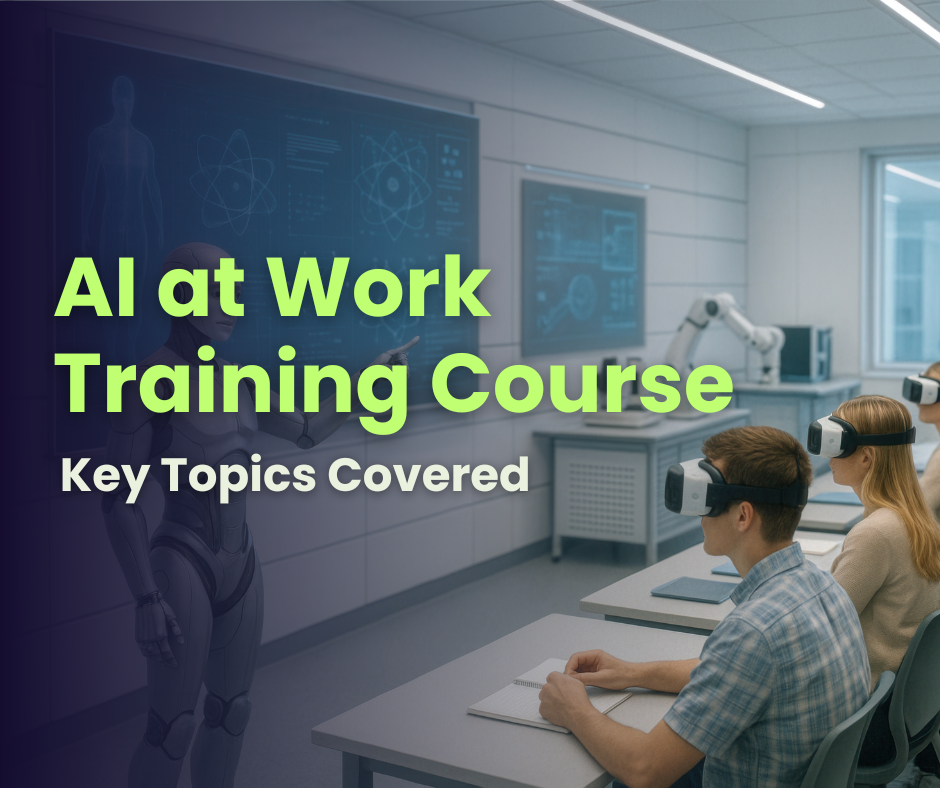
You’ve heard the buzz about Artificial Intelligence. Maybe you’ve even tried a tool like ChatGPT. It felt exciting for a moment. Then the reality set in.
How do you actually use this in your day-to-day work? What does it mean for your team? Is it worth the investment, or is it just another distraction?
These are the real questions we face. AI isn’t a future concept anymore; it’s a present-day tool. But without the right understanding, it can feel more confusing than useful.
Our “AI at Work” corporate training course is built to bridge that gap. We don’t deal in abstract theories or tech jargon. We focus on practical, actionable skills you can use immediately.
I’m David Hooi. I spent 20 years in the corporate world, leading sales teams at a multinational company. I’ve felt the pressure to perform and seen the struggle of adapting to new technologies. For the last two years, I’ve focused entirely on business consulting and training, helping companies like yours navigate AI. This course is a direct result of that experience.
Here’s a detailed look at what we cover.
1. AI Fundamentals: Demystifying the Technology
Before you can use a tool, you need to know what it is and what it isn’t. We start by clearing up the confusion.
What is AI, Really?
We strip the term back to its basics. In our course, we define AI as a set of technologies that allows machines to perform tasks that typically require human intelligence. This includes things like understanding language, recognizing patterns, and solving problems.
We focus on the types of AI that are relevant to you right now:
- Machine Learning (ML): Systems that learn and improve from experience without being explicitly programmed for every task.
- Natural Language Processing (NLP): The technology that allows machines to understand, interpret, and generate human language. This is what powers ChatGPT and other chatbots.
- Computer Vision: Systems that can derive meaning from visual inputs like images and videos.
A 2023 study by McKinsey found that while AI adoption has exploded, only a small fraction of companies see significant financial benefits. The reason? A fundamental lack of understanding of how to apply the technology strategically. We fix that.
What AI is NOT
We also tackle the common myths head-on. AI is not:
- A sentient being that can think for itself.
- A magic button that will solve all your problems overnight.
- A guaranteed path to replacing your entire workforce.
The goal here is to replace anxiety with clarity. When your team understands the mechanics, they stop fearing the technology and start seeing its potential.
2. The AI Toolbox: Practical Applications for Daily Work
This is the hands-on part. We move from theory to practice, introducing specific tools that can save hours every week.
We categorize tools based on the tasks they excel at:
| Task Category | Example Tools | Common Use Cases at Work |
| Writing & Content | ChatGPT, Claude AI, Google Gemini | Drafting emails, writing reports, creating marketing copy, summarizing long documents. |
| Design & Imagery | Midjourney, DALL-E, Canva AI | Generating social media graphics, creating presentation slides, designing concept art for proposals. |
| Video & Audio | Runway, Heygen, CapCut | Editing videos, creating short promotional clips, generating voiceovers. |
| Data & Analysis | Microsoft Copilot, Various AI Plugins | Analyzing spreadsheets, identifying trends in data, creating charts and summaries. |
How This Works in Reality
Let’s take a common task: preparing a quarterly report.
The old way: You spend days collecting data, writing summaries, and designing the presentation.
The AI-assisted way:
- You ask an AI like ChatGPT to analyze your raw data and suggest key takeaways.
- You use a tool like Gamma or Canva to generate a first draft of the presentation deck based on an outline.
- You use an image generator like Midjourney to create a unique cover image.
What used to take 8 hours might now take 2. This isn’t about cutting corners; it’s about working smarter. We guide your team through these workflows, so they become second nature.
3. Prompt Engineering: The Skill of Talking to AI
The biggest mistake people make with AI is expecting it to read their minds. The output you get is only as good as the input you provide. Prompt engineering is simply the art of giving clear instructions.
It’s not a technical skill; it’s a communication skill.
We teach a simple framework for crafting effective prompts:
- Role: Assign a role to the AI. (“Act as a senior marketing manager…”)
- Task: State the specific task clearly. (“…and write a 300-word blog post introduction…”)
- Context: Provide necessary background. (“…for an audience of SME owners in Malaysia about the benefits of AI automation.”)
- Format: Specify the desired format. (“Use a friendly tone and provide the output in three short paragraphs.”)
Let’s see the difference:
- Weak Prompt: “Write about sales.”
- Strong Prompt: “Act as a sales director. Write a 500-word email to my sales team of 30 people, motivating them for the final quarter push. The tone should be energetic and confident. Include three key strategies for closing more deals.”
The second prompt gives the AI direction, context, and a goal. The result is a usable, high-quality draft that you can then refine.
A report by Anthropic on AI usability highlighted that users who master basic prompt engineering are up to 50% more productive with AI tools than those who don’t. We make sure your team is in that 50%.

4. Building an AI-Aware Culture and Managing Change
Technology is easy. People are hard. You can have the best tools, but if your team resists them, you’ve wasted your investment.
Addressing the Fear of Job Loss
This is the elephant in the room. We address it directly with data and perspective.
A World Economic Forum “Future of Jobs Report” predicts that while AI may displace some roles, it will create many others. More importantly, it will augment most existing jobs. Think of it like the calculator: it didn’t replace mathematicians; it made them more efficient.
We help reframe the narrative from replacement to empowerment. AI handles the repetitive, time-consuming tasks, freeing up your employees for strategic thinking, creativity, and relationship-building—the truly human skills that drive business.
Leading the Shift
We provide managers and leaders with a straightforward framework for rolling out AI:
- Communicate the “Why”: Be transparent about why the company is adopting AI. Focus on growth, efficiency, and competitive advantage, not just cost-cutting.
- Start with Champions: Identify early adopters in your team who are excited about AI. Let them lead by example and share their successes.
- Provide Safe Spaces to Learn: Encourage experimentation without the fear of failure. This is a learning process for everyone.
- Focus on Ethics: We discuss practical AI ethics—data privacy, bias in algorithms, and responsible use. This isn’t just about being good; it’s about managing risk and building trust.
5. Measuring ROI and Building a Sustainable Strategy
Finally, we connect AI use to your bottom line. How do you know it’s working?
Tracking the Right Metrics
We help you identify what to measure. This isn’t about vague “productivity gains.” It’s about concrete numbers.
- Time Savings: How many hours per week are employees saving on specific tasks (e.g., report writing, content creation)?
- Cost Reduction: Have you reduced spending on external agencies for design, writing, or data analysis?
- Output Quality: Has the quality of proposals or marketing content improved? You can track this through client feedback or engagement rates.
- Revenue Impact: Are sales teams using AI to create personalized pitches faster, leading to a higher conversion rate?
A Real-World Example from Our Client
Let’s look at PLM Interiors, a contracting firm we worked with. Their challenge was intense competition and a need to optimize operations.
Before our training, their vendor selection and cost budgeting processes were slow and prone to human error. After implementing the AI strategies we taught them, their goal was to improve efficiency by four times and reduce over-budgeting by 50%. They are now tracking these specific, measurable KPIs to gauge their success. This is what practical ROI looks like.
Another client, Global Ace Maid Agency, learned to use AI to create performance dashboards and multi-lingual training content. For a company managing employees from seven different countries, this wasn’t just a nice-to-have; it was a direct solution to a critical business bottleneck.
Conclusion: This is More Than a Training Course
The “AI at Work” course isn’t a lecture. It’s a transformation. We give your team the confidence to stop being passive observers of the AI revolution and start being active participants.
You will walk away with:
- A clear understanding of what AI can and cannot do.
- Hands-on experience with the most practical AI tools available today.
- The communication skills to get the best results from these tools.
- A clear plan to manage the human side of this technological shift.
- A framework for measuring the real impact on your business.
The future of work isn’t about humans versus machines. It’s about humans with machines. And that partnership starts with the right training.
This course is the foundation for that partnership. It’s designed for corporate teams and SME owners who are ready to move past the hype and start getting real work done.
Ready to build a future-ready team? Let’s have a conversation about how our “AI at Work” corporate training can be customized for your organization’s specific needs. You can reach out to us here to get started.

